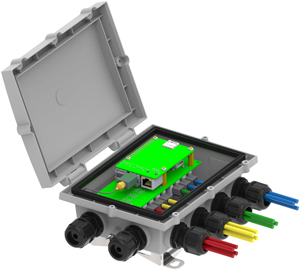Hardware protection to ensure success of outdoor wireless projects
The benefits of smart infrastructure are huge. By 2025, cities that deploy smart mobility applications have the potential to cut commuting times by 15-20% on average, according to McKinsey research. Yet without high network availability and reliability, these benefits are unattainable. This applies to every network component – even the enclosures which house key IoT hardware. Andy Bird (pictured below), Director at GTT Wireless, reveals the role ruggedised enclosures play in outdoor wireless projects, and the key capabilities needed to achieve full protection of mission-critical hardware in challenging conditions.
From smart parking and traffic management in today’s increasingly digitised cities to agricultural irrigation in the driest climates, there can be no doubt that smart infrastructure is improving quality of life, citizen safety and protecting the environment. Outdoor IoT and M2M applications are quickly developing in scale and complexity, and now play a vital role in enabling mission-critical operations and safeguarding against disruption.
Whatever the weather
These outdoor wireless deployments now operate in a huge variety of situations from agriculture and mining to utilities, transportation and Heating, Ventilation, and Air Conditioning (HVAC), and as such require seriously ruggedised enclosures to guarantee high levels of availability and reliability. Any down-time has the potential to significantly disrupt or halt operations that rely on consistent connectivity.
Components are increasingly pushed out into remote locations to ensure connectivity across large areas, and this has imposed high standards on the quality of electronics protection – making robust hardware a top priority for any IoT deployment.
As the market matures, and IoT and M2M innovation continues to broaden the applications of emerging technology, deployments now require a carrier-grade, all-in-one enclosure solution rather than a stock plastic box. In addition, this enclosure must be able to incorporate power and data interfaces, antennae and robust mounting – suitable for applications ranging from smart parking to industrial IoT sensing.
Rising market demand for resilience
EN 60950-22 and IP67 rated enclosure solutions are strongly recommended for challenging outdoor deployments to minimise risk to hardware and ensure not just resistance, but resilience in demanding environments. Qualifying enclosures must be fully waterproof, capable of resisting salt spray and submersion in water.
We know there is now a pressing need for fully customisable enclosure solutions with enhanced durability, as companies look to house sensitive electrical components away from the climate-controlled conditions of data centres and offices! Over just the past month the GTT Wireless team has received a large volume of enquiries to fill a capability gap for ruggedised enclosures, due to the lack of products that combine customisation with compliant protection against hostile environments.
One size doesn’t fit all
To ensure a suitable fit for electronics and avoid an unnecessarily large final product, ruggedised enclosures need to be available in multiple sizes. But customisation doesn’t just equate to offering a selection of enclosure dimensions.
The equipment you are housing has often involved years of development time and expensive components. Traditional prototype development requires a significant investment of time and money into sourcing and testing integration of multiple components and interfaces from various suppliers. This process is further complicated by the threat of discontinued items, inconsistent quality or the need to re-engineer off-the-shelf components.
Made to measure to protect your IoT investment
At GTT Wireless, we have developed a dedicated enclosure design tool to enable end-to-end planning and creation of bespoke enclosures, cutting the prototype development phase from months to days.
 By allowing designers to select from a wide variety of available components and test compatibility before moving to the prototype ordering stage, these pitfalls can be avoided. Providing a visual representation of the final product helps demonstrate the composition and layout of proven interoperable components, eliminating the threat of re-engineering and redesign.
By allowing designers to select from a wide variety of available components and test compatibility before moving to the prototype ordering stage, these pitfalls can be avoided. Providing a visual representation of the final product helps demonstrate the composition and layout of proven interoperable components, eliminating the threat of re-engineering and redesign.
Building enclosures to last
To ensure longevity, businesses should select a highly customisable, carrier-grade enclosure designed to resist the most challenging conditions in remote locations. Enclosures that are EN 60950-22 approved and IP67 rated represent the benchmark for deployment in harsh environments – having been proven to successfully endure extreme temperatures and weather conditions such as condensation, humidity and wind. The mSmart-Box, for example, can resist temperatures ranging from -40°C to 120°C.
We also incorporate Gore vents into the enclosure design to avoid delayed threats such as dust, pressure changes and structural failure, ensure pressure equalisation and resist any internal condensation that may pose a threat to electronics housed inside.
The reason for resilience
There is no doubt that outdoor applications of IoT and M2M technology will continue to rapidly expand into critical roles spanning industries such as utilities, transport and security. With so many individual threats posed to sensitive PCBs, selecting a comprehensive and resilient enclosure has moved from being a luxury to a necessity – delivering peace of mind that mission-critical operations are not at threat of disruption from environmental factors.










